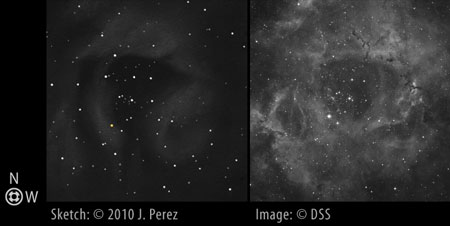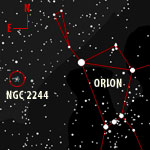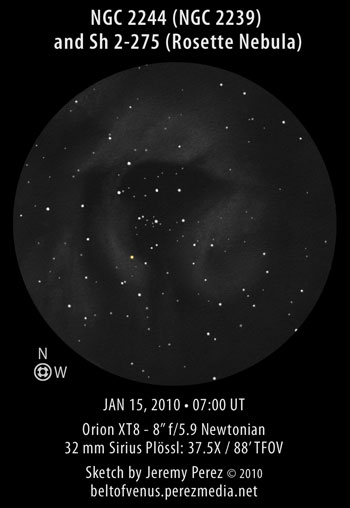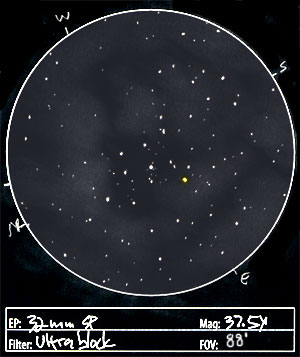Observation Notes:
If you find yourself at a dark site with Orion and Monoceros sprawled across the meridian, don't pass up this gorgeous showpiece of the winter sky. While at Sunset Crater National Monument, working on a set of observing/sketching projects, I spent an hour re-observing the nebulosity surrounding the cluster. I used a tracing of my previously sketched star field as a starting point to save time.
As before, the nebulosity was visible unfiltered, but adding the Ultrablock filter helped immensely. The central hollow was bordered by a rather straight run of nebulosity to the north. The western edge of the hollow peeled away along the northwest edge, forming a beak-like appendage. The nebula seemed to curl away on the southwestern side, allowing an opening to form on the south edge of the central void. Two nested arcs of nebulosity wrapped the east side to complete the shroud. Further out on the north east edge of the field, some more smoky structure emerged. That striking yellow-orange star still popped out along the southeast edge of the central rim.
To allow better control over the shading, I prepared this sketch in a large, 6 inch (15 cm) circle. I used an artist's chamois loaded with graphite to softly rough in the broad swaths of nebulosity. I then followed up with a graphite-loaded blending stump to build up the details and variations in luminosity.
Object Information:
The common designation NGC 2244 refers to the cluster of stars at the center of this stellar nursery. The nebulous region is described by the designations NGC 2237, 2238 and 2246. This nebula and star cluster is more than 1 degree across. Star formation is still in progress. This object lies about 5,500 light years away, and is about 130 light years in diameter. The open cluster (NGC 2244) was discovered in 1690 by Flamsteed. The nebulous regions were later discovered by John Herschel, Marth, and Swift.

Sketch/DSS Photo Comparison of NGC 2244 (NGC 2239)
and Sh 2-275 (The Rosette Nebula)
| Subject | Nebula: Sh 2-275 (The Rosette Nebula) -- Includes NGC 2237, 2238, 2246 Open Cluster: NGC 2244 (NGC 2239) | |
| Other Desig. | NGC 2244: NGC 2239, Lund 222, h 392, GC 1420, OCL 515, Cr 99, Mel 47, CED 76B Sh 2-275: NGC 2246, NGC 2237, NGC 2238, LBN 948, LBN 949, Sh2-274, GC 5361, CED 76A, | |
| Classification* | Open Cluster (III 2 m n) and Emission Nebula | |
| Position* | Monoceros [RA: 06:31:55.6 / Dec: +04:56:35] | |
| Size* | NGC 2244: 24' Sh 2-275: 80' x 60' | |
| Brightness* | NGC 2244: 4.8 bMag Sh 2-275: 6.0 bMag | |
| Date/Time | January 15, 2010 - 12:00 AM MST (January 15, 2010 - 07:00 UT) | |
| Observing Loc. | Cinder Hills Overlook, Sunset Crater National Monument, Arizona | |
| Instrument | Orion SkyQuest XT8 Dobsonian (203 mm dia./1200 mm F/L) | |
| Eyepieces/Mag. | 32 mm Sirius Plossl (37.5X / 88' TFOV) | |
| Conditions | Clear, cold, breezy | |
| Seeing | 5/10 | |
| Transparency | Mag 7+ | |
| *Sources | NGC/IC Project SEDS |
February 24, 2006 Observation:
Observation Notes:
 This is really an incredible nebula from a dark site. While the nebulosity is only hinted at without a a filter, once the Ultrablock filter is inserted, its beautiful form really takes shape. The central region is home to a bright, but sparse open cluster and is mainly clear of nebulosity, with softly glowing petals of light encircling it. The brightest portion of the nebula appeared to be north of the core, and the western quadrant appeared to be lacking in stars. A bright yellow star sparkled just east-southeast of center as shown in the sketch.
This is really an incredible nebula from a dark site. While the nebulosity is only hinted at without a a filter, once the Ultrablock filter is inserted, its beautiful form really takes shape. The central region is home to a bright, but sparse open cluster and is mainly clear of nebulosity, with softly glowing petals of light encircling it. The brightest portion of the nebula appeared to be north of the core, and the western quadrant appeared to be lacking in stars. A bright yellow star sparkled just east-southeast of center as shown in the sketch.
| Date/Time | February 24, 2006 - 11:30 PM MST (February 25, 2006 - 06:30 UT) |
| Observing Loc. | Anderson Mesa, AZ |
| Instrument | Orion SVP 6LT Reflector (150 mm dia./1200 mm F/L) |
| Eyepieces/Mag. | 32 mm (37.5X) |
| Conditions | Clear, calm, 21°F |
| Seeing | 3-4/10 |
| Transparency | Mag 6.8 |







Jeremy,
In this case I have to say I really like some of the components of your first sketch though I like the overall view in the second. How does Anderson compare to Cinder Hills Overlook in terms of darkness? Both are wonderful examples of your tremendous work. Could I ask how long you spend on each sketch? I can see when you began but not an end time on this. Thanks!
Thanks again, Jay. My experience is that Sunset Crater is the darker site. The volcano blocks the Flagstaff light dome to the southwest very well. Flagstaff's modest LP is more visible from Anderson Mesa (visible to the Northwest at that location). In both cases, dry air and high altitude keep the sky everywhere else very dark. The best site I've been to in the area is Wupatki National Monument, about another half hour further north than Sunset Crater. While Flagstaff's presence can still be detected, it is the barest smudge of gray far to the south.
Because I used the original sketched star field as a template, I only spent an hour on the nebulosity in this sketch. The M42/43 nebulosity was done in about an hour and a half. For more condensed/less complex objects, I may spend as little as 20 minutes. So, pretty much 20 minutes to 2 hours at the eyepiece, depending on the subject.
Great questions, thanks for the post.
Jeremy